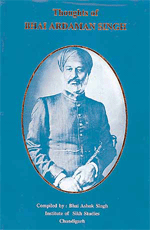by Roopinder Singh

Thoughts of Bhai Ardaman Singh compiled by Bhai Ashok Singh. Institute of Sikh Studies, Chandigarh. Pages 250. Rs 395.
BHAI Ardaman Singh Bagrian as a person is hard to define. A man steeped in tradition, but who projected himself through the modern idiom. Born in 1899, he passed away in 1976, having seen the transition from feudal India, of which he was very much a part, to independent, socialist India. He was among the towering personalities who dominated the socio-religious canvas of Punjab for a significant part of this century.
And what a personality he was as were his contemporaries! Bhai Kahn Singh Nabha, Principal Teja Singh, Giani Gian Singh, Bawa Hari Krishan Singh — they dominated the intellectual and social ethos of Punjab then. And they would often get together at Bagrian House to discuss matters and exchange ideas. This was the time when differences were resolved with civility, when people agreed to disagree with grace.
Bhai Ardaman Singh was a Sikh, a scion of a family that traced its roots to Bhai Rup Chand who was blessed by Guru Hargobind. His father, Bhai Arjan Singh, had a pre-eminent position in Sikh society of his days and the son managed to adapt to changing circumstances with aplomb.
He expressed himself with clarity and forcefulness which can be seen in his collection of writings, Thoughts of Bhai Ardaman Singh, compiled by his son, Bhai Ashok Singh. The writer is opposed to what he called plagiarism — the propensity of scholars of Sikhism to base their works on those of scholars who adhered to other traditions. A proponent of an independent Sikh religious identity, Bhai Ardaman Singh was steadfast in opposing “brahminical influences” on Sikhism.
What then is his concept of a Sikh? “Sikhs as a whole, are known as the Panth. The Panth includes all sorts of Sikhs, whether perfect or imperfect, novice or fully responsible, sehajdhari or amritdhari. Anyone who believes in the Guru and the Gurbani and has faith in no one else, cannot be denied to be a Sikh and, therefore, is a member of the Panth. For every Sikh there is a bar. Once he or she crosses this bar, he (she) is elevated to the selection grade, and after having received amrit he (she) becomes a Khalsa, a member of the Akal Purkh’s fauj (army of God), who surrender their life and are tested and consecrated with the sword, a class of God-conscious men, saint-warriors, out to protect the good and spread goodness and punish evil-doers and extirpate evil.”
Whether he is exploring historical aspects of the religion or expounding on various concepts central to the faith, the author comes across as a believer well-versed in the Gurbani and the Sikh lore. He quotes extensively from the scriptures and is an ardent advocate of an independent Sikh identity — be it religious or cultural.
It is interesting to note what he has to say on the concept of maryada. “There is no special spiritual sanctity attached to maryada in Sikhism. But it is like the Constitution of a civilised and organised government of a country, to which loyalty is sworn. It has been formed and has been evolved from time to time by the Sikhs as a whole called “Panth”. It is the point around which the whole organisation revolves and keeps together. Without a Constitution or rules and regulations, no society or individual can properly function. Without this regulation everything becomes a total chaos. It is a matter of strategy for protection and advancement of the Sikhs, to co-ordinate and integrate and keep them on the path. Maryada has evolved and changed according to the requirements, needs and conditions through which the Panth has passed. It will have to adapt itself and change in future also when necessity and urgency of the situation calls. A static constitution is always fatal to the cause. Our maryada, therefore, has to be dynamic and a living, pulsating and functioning Constitution. But it has to conform to and be subservient to the spirits and tenets laid down in the Satguru’s Shabad incorporated in the Guru Granth Sahib.”
Various heads as diverse as Guru Nanak’s way of life, simran, the Sikh sword, worship, singing the lord’s praises, karam gratefulness sant sadh sangat, women among the Sikhs, renunciation, clothes, food and unity, intolerance and culture are discussed in this compilation. The chapter on ardas is particularly interesting for readers who are not too familiar with the various aspects alluded to in the prayer.
As a reader peruses various topics in the book, he would see the work of an ardent believer and proponent of Sikhism who has expressed himself forcefully. The reader would have to keep in mind the time frame which set the tone of the writing, though the thoughts expressed through it transcend temporal limitations.
